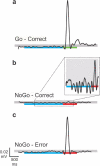Neurophysiology of movement inhibition during full body reaching
- PMID: 36114252
- PMCID: PMC9481520
- DOI: 10.1038/s41598-022-18677-9
Neurophysiology of movement inhibition during full body reaching
Abstract
Our current understanding of response inhibition comes from go/no-go studies that draw conclusions based on the overt movement of single limbs (i.e., a single finger pushing a button). In general, go/no-go paradigms have found that an individual's ability to correctly inhibit the motor system is indicative of a healthy central nervous system. However, measuring inhibition by an overt behavioral response may lack the sensitivity to conclude whether the motor system is completely inhibited. Therefore, our goal was to use behavioral and neurophysiological measures to investigate inhibition of the motor system during a full-body reaching task. When directly comparing neurophysiological and behavioral measures, we found that neurophysiological measures were associated with a greater number of errors during no-go trials and faster onset times during go trials. Further analyses revealed a negative correlation between errors and onset times, such that the muscles that activated the earliest during go trials also had the greatest number of errors during no-go trials. Together, our observations show that the absence of an overt behavioral response does not always translate to total inhibition of the motor system.
© 2022. The Author(s).
Conflict of interest statement
The authors have no competing interests to declare. Stephen A. Coombes is cofounder and manager of Neuroimaging Solutions, LLC. Grant support for Ho was provided by the National Center for Advancing Translational Sciences of the National Institutes of Health under University of Florida and State University Clinical and Translational Science Awards TL1TR001428 and UL1TR001427. The content is solely the responsibility of the authors and does not necessarily represent the official views of the National Institutes of Health.
Figures




References
-
- Nosek BA, Banaji MR. The go/no-go association task. Soc. Cogn. 2001;19:625–664. doi: 10.1521/soco.19.6.625.20886. - DOI
Publication types
MeSH terms
Grants and funding
LinkOut - more resources
Full Text Sources

